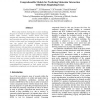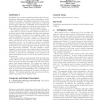73 search results - page 7 / 15 » Learning to predict where humans look |
APGV
2004
ACM
14 years 1 months ago
2004
ACM
Many common materials, including fruit, wax and human skin, are somewhat translucent. What makes an object look translucent or opaque? Here we use a recently developed computer gr...
ACL
2004
13 years 9 months ago
2004
Sentiment classification is the task of labeling a review document according to the polarity of its prevailing opinion (favorable or unfavorable). In approaching this problem, a m...
ETRA
2006
ACM
14 years 1 months ago
2006
ACM
Next-generation immersive virtual environments and video games will require virtual agents with human-like visual attention and gaze behaviors. A critical step is to devise effic...
ICMLA
2008
13 years 9 months ago
2008
When using machine learning for in silico modeling, the goal is normally to obtain highly accurate predictive models. Often, however, models should also bring insights into intere...
WSDM
2009
ACM
14 years 2 months ago
2009
ACM
Readability is a crucial presentation attribute that web summarization algorithms consider while generating a querybaised web summary. Readability quality also forms an important ...


